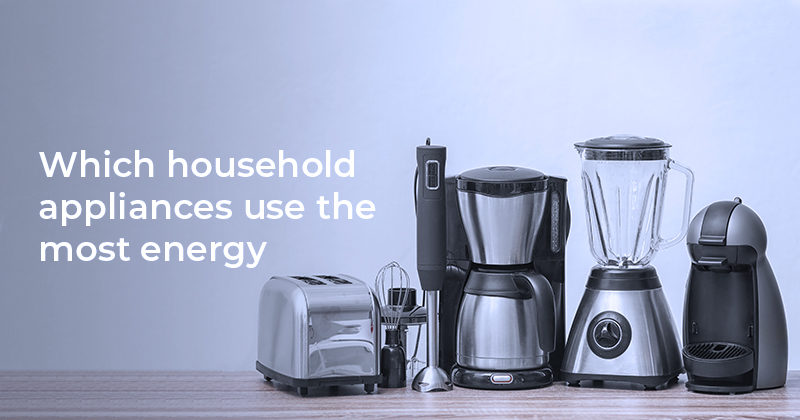Which Household Appliances Use the Most Energy?

Spiking electricity bills are something we are all affected by. Domestic energy rates have risen substantially over the past decade, and it can often feel like they just keep getting higher.
Electricity price rises are due to a few factors, such as maintenance and upgrades to infrastructure, increased charges by electricity retailers for billing customers and a lack of competition in the wholesale electricity market. However, there are ways you can reduce your electricity bill to better manage these price rises.
When your electricity bill is higher than you’re expecting, it pays to be wary of the appliances you use and how much electricity they’re consuming. General household appliances can be responsible for more than 30% of your energy consumption.
Reflect on your daily usage habits and consider if there are areas you could improve on. Do you often forget to switch lights off when leaving a room? Do you use a dryer when you could hang your clothes on the line instead? Knowing these habits and looking for ways to improve is a positive step forward into creating an energy efficient home.
As a homeowner, it’s also important to understand there are certain appliances that consume more energy than others. Below is a quick guide on which appliances consume the most energy so you can limit their use or upgrade them to more energy-efficient models:
Air Conditioning Units
If you notice the bill spike occurs more often during the very hot and cold periods, your air-conditioning unit is most likely the culprit. Cooling and heating the space in your home can contribute to almost 40% of your total energy bill.
Water Heaters
Another heavy energy-drainer that may have caused the spike in your electricity bill is water heating, which takes up 25% of your overall power consumption and is the second largest segment of household energy use. A single hot bath consumes over 140 liters of water.
Dryers
Tumble dryers are certainly a convenient purchase; however, they can very quickly start to increase your electricity bill. Regularly using your clothes dryer can cost you anywhere from $100-$650 a year.
Hair dryers are also energy-draining appliances that can consume up to 1500 watts of power in the highest heat setting.
Refrigerators and Freezers
The energy consumption of a fridge depends on the capacity size of the unit. An average Australian home tends to have a 600L fridge with an annual running cost of $166. As your fridge and freezer is constantly running, it can easily contribute to a high electricity bill.
TV
Your TV ranks third amongst the appliances that use up the most energy in your household. However, LCD LED TV’s are considered to be the most energy efficient.
How Can I Make My Home Energy Efficient?
- Unplug idle appliances
Standby power is one of the main factors that contribute to spikes in your bill. Did you know you can save up to $100 a year just by pulling the appliance plug off the wall? Make it a habit and soon you won’t have to think about it.
- Swap for LED bulbs
Unlike incandescent light bulbs, LED bulbs consume up to 80% less wattage to light up your home. Plus, they last longer than other types of bulbs, so you’ll be able to get the most bang from your buck by using LED lights in your household. - Invest in energy-efficient appliances
Thanks to advances in technology and design, we now have access to more energy efficient appliances for our homes. An energy efficient washing machine can save you 25% off lifetime running costs! Be sure to check the number of stars in their energy rating as well. The higher number of stars, the more energy efficient the model is.
Your fridge and/or freezer should be one of the first household appliances you upgrade to become energy efficient. The fact that these appliances need to run 24 hours a day mean there aren’t many things you can do to reduce their consumption other than making sure you purchase a suitable capacity size and invest in a high energy efficiency model. Fortunately, there are a range of models available on the market which are highly energy efficient and affordable to purchase.
- Turn off your lights
A classic rule in saving energy. Turning off your lights is the simplest way you can lower your energy use. In the flick of a switch, you can reduce your electricity consumption and extend the life of your light bulb.
- Find alternative ways to cool down and warm up
As heating and cooling equates to such a large portion of your electricity bill, it’s worth finding cheaper alternatives to achieve the same result. Warming up when it’s shivering cold may seem impossible at times, but slip on some socks, a beanie and cup of hot tea and you’ll find it can take the cold sting away. You’ll be surprised what an ice-cold drink and quick 2-minute cold shower can do for you in summer.
- Hang your clothes on the line
Where possible, hang your clothes on the washing line outside. If you live in an apartment, a clothes line may not be feasible. However, you can purchase a small indoor clothes line for about $10.
If you’re interested in finding out how much you could save by going solar, contact us today for an obligation free discussion about your options.


